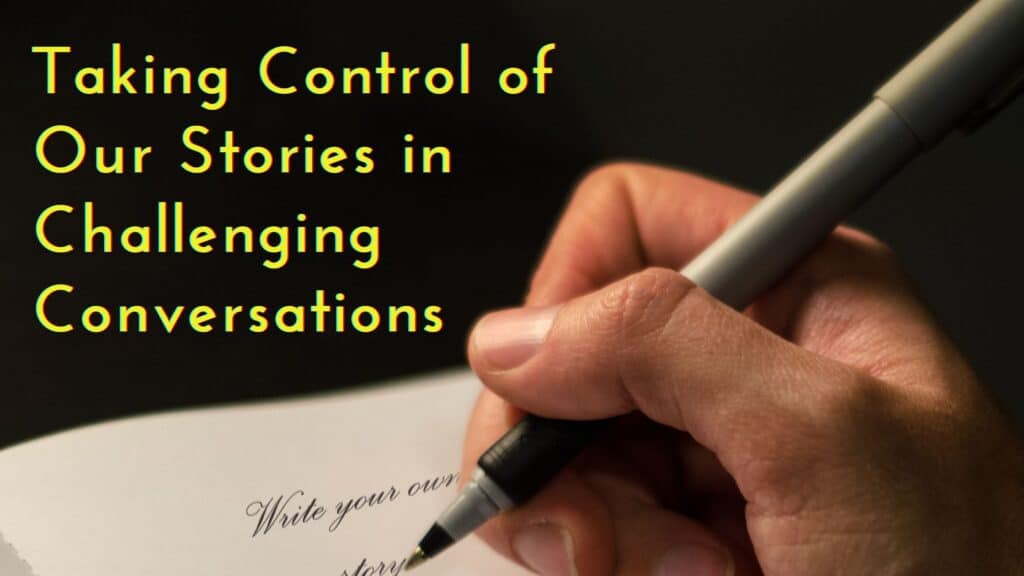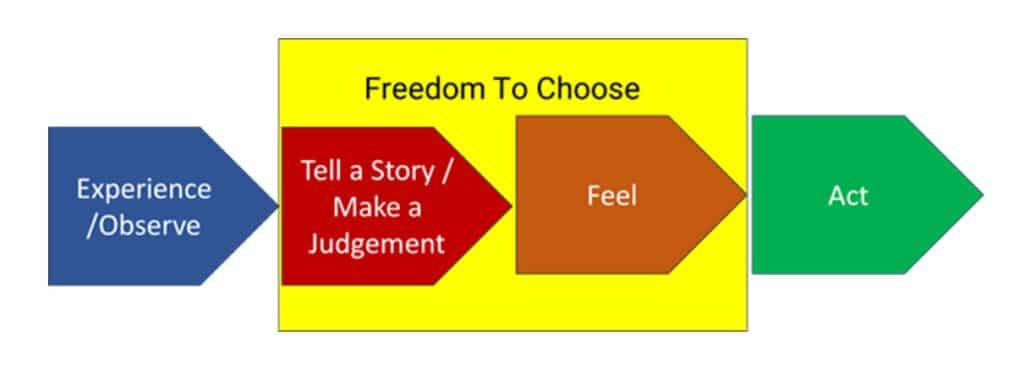
In our daily lives, we often react instinctively to high-stakes situations. Later, we might reflect and realize that our initial response wasn’t the best choice. A lot of this comes down to the stories we tell ourselves in the heat of the moment. By understanding and controlling these personal narratives, we can significantly improve our personal and professional lives.
The Stimulus-Response Model
The Stimulus-Response Model suggests we have two options: react based on emotion or respond thoughtfully, guided by our values. When we recognize the stimulus and consciously choose our response, we align our actions with our goals and values. This leads to more mindful decisions and fewer impulsive reactions.

The Three Conversations
In “Difficult Conversations”, authors Douglas Stone, Bruce Patton, and Sheila Heen talk about three types of internal conversations we have when facing a challenging situation: the “What Happened” conversation, the Feelings conversation, and the Identity conversation.
The “What Happened” conversation focuses on our version of the facts and how we interpret them. The Feelings conversation is about our emotional reactions. The Identity conversation concerns how the situation impacts our self-perception, self-worth, and well-being. These internal dialogues shape our responses and significantly influence the outcome.
The Story-Making Process
In “Crucial Conversations”, authors Joseph Grenny, Kerry Patterson, Ron McMillan, Al Switzler, and Emily Gregory introduce the Story-Making Process, which explains what happens when we decide how to respond. We create a narrative or judgment based on our interpretation of events. Our brains are wired to find meaning, and we rely on past experiences, beliefs, assumptions, and selective perceptions to shape our stories. I’ve adapted this Story-Making Process into the Stimulus-Response Model that I mentioned earlier.

Personal beliefs, often formed in childhood, color how we see situations. Past experiences create patterns in our reactions, making us respond similarly in new situations. Selective perception leads us to focus on information that supports what we already believe, reinforcing our narratives. Understanding these factors helps us manage our stories more effectively.
Common Narratives
We tend to tell ourselves three types of stories: the Victim, the Villain, and the Helpless stories. In the Victim story, we see ourselves as the wronged party. The Villain story blames others for our problems. The Helpless story portrays us as powerless to change things. These narratives can hold us back and prevent progress in conversations. By recognizing these traps and reframing our stories, we empower ourselves to take positive action.
Taking Control of Our Stories
Once we’re aware of our internal narratives, we can start to take control of them. This involves pausing to ask ourselves if the story we’re telling and the emotions it’s triggering are helping or hindering the conversation. We can examine our story by asking questions like:
– Am I acting out my concerns instead of expressing them?
– What emotions am I feeling, and why?
– What story am I telling myself that’s creating these emotions?
– What evidence supports or contradicts this story?
– Is there another way to interpret what’s happening?
We can also reassess our own role in the issue. Have we contributed to the problem, intentionally or not? Are we letting biases or assumptions cloud our judgment? What do we really want for ourselves and the other people involved? What can we do right now to move the conversation toward a positive outcome?
Key Takeaways
Understanding and managing our self-narratives is a powerful tool for personal and professional growth. By becoming more aware of our internal stories and emotions, we can make better choices in our actions. Practicing mindfulness helps us pause and examine our emotions and stories.
Taking control of these stories requires humility, respect, and curiosity. Humility helps us acknowledge that we don’t always have the full picture and may have contributed to the issue. Respect ensures that even in disagreements, we engage with others thoughtfully. Curiosity, combined with humility and respect, allows us to see situations from new perspectives.
This article focuses on what’s within our control because I believe that’s the key to navigating challenging conversations successfully. There are other important skills for productive communication, but increasing self-awareness and emotional agility is a great first step.

